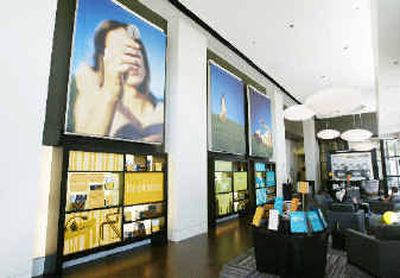Community banks rely on personal assets

PORTLAND — There are no velvet ropes or marble teller’s counter, no dark wood or imposing glass panels. Instead, the interior of Umpqua Bank has the feel of a sleek living room — hip leather chairs flank a plasma TV screen, with a shelf of best sellers nearby.
The bank offers more than just cozy decor — customers can sign up for yoga class and movie night.
“What if we felt like home?” asks Umpqua Bank’s chief executive Ray Davis. It’s the Oregon bank’s latest advertising line, emblazoned on billboards and the sides of buses.
Nationwide, community banks like Umpqua are a creating a niche for themselves by giving customers an environment that invites them to linger. Financial giants have been weaning customers off of human contact with automated teller machines and Internet banking — leaving an opening for small and mid-sized banks to go for the personal touch.
“It’s part of a trend in business which tries to make transactions an experience — rather than just a transaction,” said Charlotte Birch, spokeswoman for the American Bankers Association.
Spokane-based Wheatland Bank took a page from a retailer’s manual when it decided to build new branches a few years ago, said Susan Pittman Horton, the bank’s CEO.
“Retail stores do everything they can to get you in the doors,” she said.
That’s why Wheatland chose for its lobbies earth tones and comfy furniture, televisions, coffee bars and “computer cafes” for Internet transactions, Pittman Horton said.
“As a community bank our approach is to have in-depth relationships with our customers,” she said. “To push them out of the (bank’s) lobby didn’t make any sense to us, so we came up with a design concept … that’s a very comfortable living-room environment.”
Keeping kids entertained is another strategy small banks use.
At Harleysville National Bank in Pennsylvania, the main branch is equipped with an adult teller counter and a shorter one for children. After serving parents, the bank serves children, for example, helping them keep track of their savings in special bank books. In all of its 45 branches, the bank deposits $1 into children’s accounts for every book they read, up to $10.
In El Segundo, Calif., Hawthorne Savings, which was recently acquired by Commercial Capital Bank, rewards children with toys when they deposit money into savings accounts.
The personal touch trend has made enough of an impact that bigger banks are rethinking their strategies.
“A checking account is a checking account is a checking account. The only way to differentiate yourself is through service,” said Laura Schulte, Wells Fargo’s regional president.
In California, Wells Fargo and Bank of America have signed contracts with Starbucks to operate a coffee shop inside select branches. Bank of America is also testing a mini-bank where children can “play teller,” said Amy Brady, the bank’s innovation and development executive. Children can also use a computer terminal to log on to Disney.Com and entertain themselves while parents bank.
At Seattle-based Washington Mutual, a “teller action doll” is given to customers at special promotions.
“It’s the teller as superhero — it’s a way of drawing attention to our unique style of banking,” said Mary Kelley, Washington Mutual’s senior vice president of corporate communications.
Washington Mutual has a play area for children as well as a concierge desk.
The trend has also caught the attention of international players. ING Direct, part of Amsterdam-based ING, has three “cafes” in offices in Los Angeles, Philadelphia and New York, with a fourth scheduled to open in Delaware this fall. The tellers play the role of barista, said spokeswoman Ashlee Stokes. “The people who pour the coffee are trained sales associates,” she said.
Portland-based Umpqua Bank is trying to stay personal even as its assets have swelled from $140 million a decade ago to nearly $3 billion today. It has 64 branches and recently announced plans to expand into Washington and California.
Founded in 1953 by loggers in southern Oregon who were fed up with driving long distances to cash their checks, the bank always targeted customers who felt ignored by larger institutions.
“The big banks had created a vacuum,” said 77-year-old Milton Herbert, the only surviving founder of Umpqua Bank.
In 1996, newly hired CEO Ray Davis changed the bank’s atmosphere. Branches began serving coffee — not just a pot of generic brew, but the company’s own blend.
By inviting customers to linger, Davis borrowed a core concept of the retail industry.
“There is a direct relationship between the time spent in a store and the average amount that you buy,” said Dan Stanek, executive vice president of Retail Forward, a retail research and analysis firm in Columbus, Ohio.